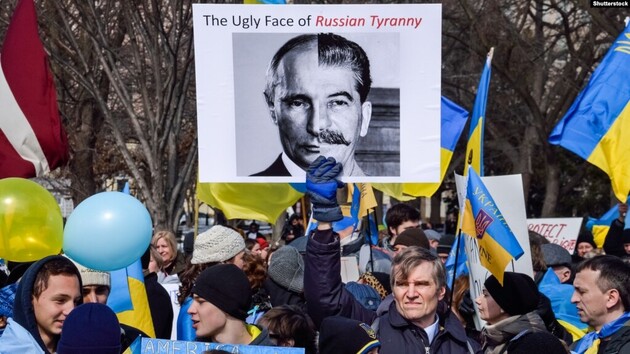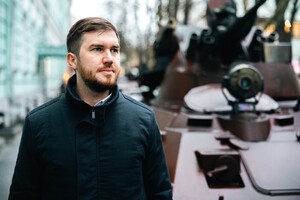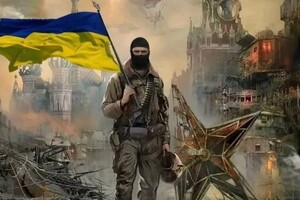How have Stalin and Putin come to the genocide of Ukrainians?

One can briefly answer the question like this: Stalin and Putin arrived by somewhat different yet very similar trajectories. These two trajectories are typologically similar and share something intrinsic to both dictators and the forces that stood behind them; I would even say it is something that is intrinsic to the Russian people. These trajectories are sometimes so similar that you start believing in the saying “history repeats itself”.
Or rather, it used to repeat itself. If we speak about present-day Russian aggression and genocide, something has happened. It seems as if those committing genocide have stopped in surprise and are beginning to back down. Are even, perhaps, ready to enter into some kind of negotiations. This was not what happened with the Holodomor. Stalin succeeded in his organization of genocide. It is no accident that the XVII Congress of the Communist Party, held in early 1934 to politically consolidate the consequences of the Holodomor, was called the "congress of winners."
Why is today not like the Holodomor? Is Russia in fact ready to back down? What similar characteristics do both trajectories share, and what is intrinsic to both dictators and to the Russian people?
To answer these questions, we have to examine both Stalin and Putin as these dictators are the ones who orchestrated what happened in 1932-1933 and what is happening now.
Starting point: acquiring absolute power
The first thing we need to do is find a starting point; especially when we are comparing two large-scale historical events separated by 90 years. Let's begin by breifly outlining the step by step evolution of both dictators to genocide.
The first step is gaining power. Without power it is impossible to arrange any genocide, because the mechanism to implement the orders will not operate, and any decisions made will get stuck somewhere in the middle. For our purposes, we can say that Stalin gained such power in late 1929, when he finally cracked down on the opposition, and that Putin began to enjoy it around the time he dispatched the oligarch Khodorkovskyi in 2005. As is often the case with Russia, both men’s authority soon became absolute, not limited by anyone or anything. This is the first similarity between two dictators.
The second similarity arises from another trend that is intrinsic to any despotic style of government: the dictator’s hold on power quickly loses its self-sufficiency. The rulers need to fortify their hold by looking elsewhere: their focus shifted from gaining power from within to providing motivation and promoting missions from outside their borders. The second great similarity between these two is that their missions are the same.
Formulations of missions
The first mission is the same for both dictators: confrontation with the West, Western civilization, values and lifestyles, or, in other words, Capitalism, Capitalist civilization, values and lifestyles. Sooner or later, explicitly or implicitly, both men challenged the West, relying on the Russia-West opposition that seems intrinsic to Russian society. The dream is to dominate the world stage, either by "igniting the fire of a world communist revolution in the world", "building the communism in a single country," under Stalin, or heralding the emergence of a multipolar world where Russia’s sphere of influence covers Ukraine, under Putin. In both cases, it is about the struggle against the West and the desire to be at least their equal. Perhaps every successful Russian ruler-typical Russian crazy idea.
The second mission concerns the underlying belief that allowed both dictators to rail against the "hegemony" of the West: the primordial Russian motive, if we paraphrase Raphael Lemkin, to create unity "not by uniting the ideas and cultures but by completely destroying all cultures and all ideas, except the one - the Soviet one" (now let’s add - Russian). Nowadays, they would call it the "Russian world"; in Stalin's time, it was called "building communism or socialism in the USSR or in the world." For convenience, we will call Lenin’s and Stalin’s project the "communist world."
Assimilating other peoples and cultures—or simply, others—became the Soviet and now Russian project. The “others” had to disappear, or at least lose most of their identity, and merge into one Soviet or Russian people. It is true that each case had quite different expectations and claims: communism was much more ambitious. However, in general, we’re talking about the same thing: the imperial modus operandi of modern Russian civilization, including the Soviet one. It is the Russian motive that Ukraine has had to learn at its own expense.
Stalin and Putin. Emergence of Ukraine, first victories and defeats
Both dictators began by moving towards mission realization. Stalin's way included industrialization and collectivization, changing society through violence. Putin's way has been the market accumulation of capital. In the first case, Soviet society was destroyed, with the resulting wreckage modernized. In the second case, Russia modernized gradually, as prescribed by textbook authoritarian leaders, so Putin did not have to recreate the wheel. Stalin's tasks, which aimed to create a competitive state practically from scratch, were much more difficult. Putin only needed to restore the former greatness of the superpower created by Stalin.
Ukraine is, figuratively speaking, the narrow bottleneck appearing in the trajectories of both dictators. These bottlenecks occurred owing to one phenomenon: a special, stubborn, resistance to the dictators’ will. This is where the history of genocides starts, even if the dictators themselves did not realize it.
Look back to the Orange Revolution or the Revolution of Dignity, at the resistance that we had then and Ukrainian rage. This same resistance took place in 1930. No peasant who lived in the Soviet Union could truly accept collectivization, which derogated their natural rights and destroyed a millennia-old way of life. However, resistance was greatest in Ukraine—the most stubborn, the most uncompromising. Communist representatives were expelled from hundreds of Ukrainian villages. Rebels seized the district centers and controlled the entire districts and dozens of villages, especially along the Ukrainian-Polish border. These were very serious acts of disobedience from people who were used to being absolutely obedient. It was, for all intents and purposes, an uprising.
Putin, just like Stalin in 1930, was faced with disappointment in 2004. Modern Ukrainians, applying tactics not too different from those used by Ukrainian peasants in early years of collectivization, ruined Putin’s plans during the Orange Revolution, when they sent the pro-Russian presidential candidate Yanukovych packing.
What did Stalin and Putin do next? Naturally, they mobilized more forces to fight against Ukrainian peasants (Stalin), politicians and activists (Putin). Their focus gradually shifted to the second principal motive—building a "Russian" or "Communist” world (which could not be done without Ukraine). Stalin seemed to have succeeded: the active insurgency in Ukraine was destroyed through repression. In 1932, Ukrainian peasants were again forced to join the collective farm as life condensed to one crucial thing: how to survive and somehow to feed their families and children. Lands which had been passed down from father to son were lost forever.
Putin's Russia also began to pursue an extremely aggressive and initially successful policy of Ukrainian economic and informational suppression. The legacy of the Orange Revolution seemed to be destroyed when Yanukovych, in his second attempt, became the president of Ukraine, in 2010. It seemed that Stalin and Putin should have been celebrating their victories as a job well done. However, their expectations were dashed and Ukrainian resistance was once again to blame.
They did not give up
Look at Belarus in the early 1930’s, and in the first two decades of the 21st century. Ukrainians could have, like them, just as easily reconciled themselves to Soviet and Russian domination without causing outright conflict,, choosing security and subordination in exchange for the loss of their rights, prospects for their future and the gradual erosion of their own identity. Many groups and peoples resisted both dictators, but generally without success. They were pressured, they bent, and the Russians happily made another notch for victory in their records. What would have happened if Ukrainians had agreed to become a part of the "Russian world," accepted Yanukovych as their president, and reconciled themselves to Russian domination? The Ukrainian state would have survived in name, and genocide and mass violence would have been unnecessary.
However, Ukrainians are not Belarusians, Georgians, Chechens, Armenians, and certainly not Russians. They did not cave in. What’s more, they continued their struggle even after defeat, facing difficult, sometimes hopeless, conditions.
Even under conditions of growing famine, Ukrainians refused to do what Stalin demanded of them: to just work. No government could force them to work selflessly in other people's fields for other people's interests. "It is better to die than to work in a collective farm for nothing": this is something specifically intrinsic to Ukrainians.
There was a transformation from active resistance (which was no longer possible) into passive resistance: petty theft of food, a lack of desire to work and at collective farms, deliberate damage to equipment and machinery, poor care of collective farm livestock, etc. We can call all these actions by one word—sabotage. Ukrainians refused to obey even under conditions of massive famine.
In the 2010s, passive resistance in Ukraine was not the same as that practiced by Ukrainian peasants in 1932. How could it be, as Ukraine was an independent country, not a territory completely dependent on Stalin. Their passive resistance resulted in famine, which turned into the Holodomor. Putin could not organize a new mass famine in Ukraine in the 2010s, or even now. What makes these two cases relevant for comparison is the fierce Ukrainian resistance to Russian imperial neo-colonial policies and to those people who represented their interests in Ukraine. The most prominent example of this resistance is the Revolution of Dignity, which was triggered by Yanukovych's refusal in November 2013 to sign the EU-Ukraine Association Agreement in Vilnius, for which he ultimately paid the price. Yet Ukrainians continued to struggle, despite Russia's occupation of Ukrainian Crimea and its invasion of Donetsk and Luhansk regions in 2014.
Genocide as a tool of obedience
Stalin and Putin were faced with the same problem of how to overcome such stubborn and fierce Ukrainian resistance.
The traditional choice of response was limited to two options: either to press on or to retreat (at least for the time being). Capitulation would not be acceptable, as it would seem to them like weakness—both Stalin and Putin would see this as tantamount to defeat. The only thing left to do was to tighten the screws further, but how? Continue to requisition grain and other foodstuffs, arrest and exiling kulaks and those who supported them, attempt to raise discipline in the collective farms—could this have led to a concrete result in the face of total sabotage? Doubtful, and it would take a long time. Putin could have tried to pressure Poroshenko and Zelenskyi, tried to push DPR-LPR into Ukraine, intensified the hostilities at the contact line, and cut off the gas supplies. Could these measures have led to a concrete result, considering the Ukrainian public consensus that it is unacceptable to surrender the national interests for the sake of "stability" and friendship with Russia,? could this have led to a concrete result? Doubtful, and it would take a long time. And the dictators had no time.
In both cases, the screw bagan to turn the more it was tightened. However, the problem was still not solved. It was then that the dictators decided on genocide.
In both cases, we are dealing with experienced predators who know very well what they are doing, and with the experience to impose obedience by force. They both found themselves in similar hopeless (in their opinions) situations, and they reacted to them in the same way. The historical memory of the Russian people has been preserved in the blood of the Russian people, and the institutional memory of genocidal violence has been preserved in the bowels of the Russian security agencies.
So they decided on aggression and genocide, hoping that experience and the suddenness of attack would play a decisive role. This was not a spontaneous decision but rather a very well thought out, rational one that, if successful, promised each dictator significant dividends—economic, political, and symbolic. In their view, the risk was not high.
Both attempted to solve all their issues in one fell swoop. Both wanted the same thing—to overcome Ukrainian Resistance; to teach a lesson to the disobedient; to cultivate loyalty— turning those who remained into "Soviet/Russian" people. Additionally, Putin wants to occupy a portion of Ukrainian land and bring the rest under his control. This was unnecessary for Stalin, as he already controlled almost all of Ukraine. Either way, they deliberately decided against tightening the screw any further—the thread was worn out. Instead, they both chose to break the entire piece in order to try to mold something new in its place.
Genocide solved all their problems and was an absolutely rational choice in terms of their logic. Stalin overcame the active armed resistance but could not achieve his goals. Putin failed to achieve his goals through diplomacy, blackmail, and military action with limited contingent.
To organize the genocide, Stalin resorted to additional mechanisms for confiscation of all food; "black boards" and prohibition for travel outside Ukraine; restrictions on movement within Ukraine, all while increasing repression. Putin used a full-scale military invasion followed by mass killings; deliberate attacks on shelters, evacuation routes and humanitarian corridors; indiscriminate bombing of residential areas; and Russian military sieges: all culminating in a deliberate and systematic creation of life-threatening conditions, sexual violence, rape and the forced displacement of Ukrainians.
What to expect and what to do next?
It remains to be seen whether Putin will succeed in achieving his goal. What is clear now is that he missed his target when he ordered the invasion of Ukraine on February 24: he chose a too strong candidate for the role of victim and failed to prepare well enough. He underestimated the Ukrainian capacity for resistance and Ukrainian rage. However, the fight is far from over. The aggressor is just beginning to improvise, as it is forced to do when faced with resistance it had not expected. There has been nothing like this in Russian history, which is rich in wars and violence. Yes, of course, Russia has fought and been defeated, but it has never started any genocide that it could not bring it to a victorious conclusion. It’s not surprising that Putin does not know what to do.
It is now obvious that a struggle lies ahead. It is no longer possible to return to the pre-war balancing act, even if a ceasefire is reached. This generation of Russians has made its choice. It cannot be reversed. A critical mass of Russian elites, and Russians in general, have embarked on the path of genocidehey cannot simply get off. They can postpone it, accept the failure for some time but not abandon it in the short term.
Therefore, Ukrainians need to understand and accept (the sooner the better) that in the next 20 to 30 years we will have to deal with, one way or another, a people who are more numerous, powerful and richer, who possess nuclear weapons, and who not only seek to defeat Ukraine and bring Ukrainian territory under their control, but to commit genocide.
Read this article in russian and Ukrainian.
Please select it with the mouse and press Ctrl+Enter or Submit a bug















 Login with Google
Login with Google